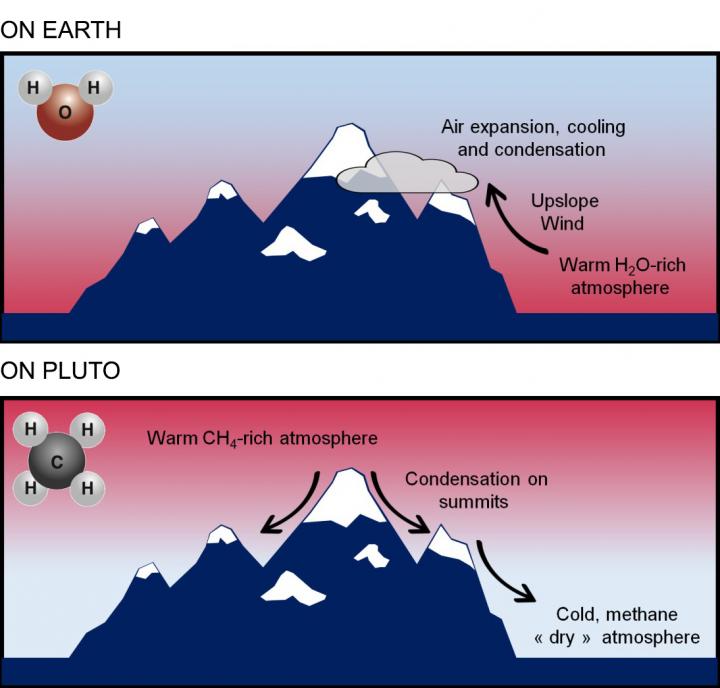The mountains of Pluto are snowcapped …

On Earth snow condenses at altitude because air dilates during ascending movements, and thus cools (at the rate of 1°C approximately every 100 m). On Pluto, methane ice forms on the peaks of mountains when they are high enough to reach upper atmospheric levels, which are hotter and rich in methane.
Credit: Tanguy Bertrand et al.
… but not for the same reasons as on Earth
In 2015, the New Horizons space probe discovered spectacular snowcapped mountains on Pluto, which are strikingly similar to mountains on Earth. Such a landscape had never before been observed elsewhere in the Solar System.
However, as atmospheric temperatures on our planet decrease at altitude, on Pluto they heat up at altitude as a result of solar radiation. So where does this ice come from? An international team led by CNRS scientists* conducted this exploration.
They first determined that the “snow” on Pluto’s mountains actually consists of frozen methane, with traces of this gas being present in Pluto’s atmosphere, just like water vapour on Earth.
Then, to understand how the same landscape could be produced in such different conditions, they used a climate model for the dwarf planet, which revealed that due to its particular dynamics, Pluto’s atmosphere is rich in gaseous methane at altitudes.
As a result, it is only at the peaks of mountains high enough to reach this enriched zone that the air contains enough methane for it to condense. At lower altitudes the air is too low in methane for ice to form.
This research, published in Nature Communications, could also explain why the thick glaciers consisting of methane observed elsewhere on Pluto bristle with spectacular craggy ridges, unlike Earth’s flat glaciers, which consist of water.
*- Scientists from the IPSL Dynamic Meteorology Laboratory (CNRS / Sorbonne Université / École polytechnique / ENS Paris), the Institute for Planetary Sciences and Astrophysics of Grenoble (CNRS / Université Grenoble Alpes), the NASA Ames Research Center, and the Lowell Observatory (Unite States) took part in this research.
All latest news from the category: Physics and Astronomy
This area deals with the fundamental laws and building blocks of nature and how they interact, the properties and the behavior of matter, and research into space and time and their structures.
innovations-report provides in-depth reports and articles on subjects such as astrophysics, laser technologies, nuclear, quantum, particle and solid-state physics, nanotechnologies, planetary research and findings (Mars, Venus) and developments related to the Hubble Telescope.
Newest articles

Properties of new materials for microchips
… can now be measured well. Reseachers of Delft University of Technology demonstrated measuring performance properties of ultrathin silicon membranes. Making ever smaller and more powerful chips requires new ultrathin…

Floating solar’s potential
… to support sustainable development by addressing climate, water, and energy goals holistically. A new study published this week in Nature Energy raises the potential for floating solar photovoltaics (FPV)…

Skyrmions move at record speeds
… a step towards the computing of the future. An international research team led by scientists from the CNRS1 has discovered that the magnetic nanobubbles2 known as skyrmions can be…





















